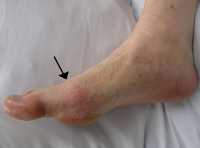
09 Jun Joint Replacements in Gout Patients Are Prevalent and Costly
MedicalResearch.com Interview with:
Dr. Prof. Dr. Gurkirpal Singh, MD
Adjunct Clinical Professor of Medicine
Stanford University
MedicalResearch.com: What is the background for this study?
Response: Joint damage from gout has been linked to a possible increase in knee and hip joint replacements. The strong association between gout and osteoarthritis could also lead to an increased risk of joint replacements in patients with gout as the presence of gout may accelerate or worsen osteoarthritis.[i]
This study aimed to evaluate total or partial hip and knee joint replacements in patients with gout in the U.S. and to estimate their economic impact. Data was analyzed on hospitalizations in patients with gout with hip and knee joint replacements in 2018, using the Nationwide Inpatient Sample (NIS) which is the largest publicly available all-payer inpatient healthcare database.
MedicalResearch.com: What are the main findings?
Response: The analysis found that in 2018 there were 914,510 hospitalizations with primary or secondary diagnosis of gout in the U.S. Of these, 43,615 were for joint replacement surgeries, including knee (24,840) and hip (18,775). The total annual national cost estimate for gout patients with hip and knee replacements in 2018 was $3.09 billion, with government insurances (Medicare and Medicaid) responsible for 67% of knee replacement and 70% of hip replacement costs.
MedicalResearch.com: What should readers take away from your report?
Response: Joint replacements in gout patients are prevalent and have a significant clinical and economic burden in the U.S., costing over $3 billion annually. This analysis adds to the growing body of evidence that gout is a serious disease that commonly co-occurs with other important diseases and requires urgent, comprehensive treatment to prevent far-reaching clinical and economic consequences. The outcomes additionally support the need for increased awareness and management of hip and knee arthritis in patients with gout.
MedicalResearch.com: What recommendations do you have for future research as a result of this work?
Response: This study helps add to insights on the impact of gout for patients and the health system. As we begin to understand the growth in hospitalizations and joint replacements in gout patients we can better understand the extent of the burden of disease and identify ways to address it.
MedicalResearch.com: Is there anything else you would like to add?
Response: Often the treatment of gout focuses on alleviating the symptoms of painful gout flares. However, when the underlying accumulation of urate crystals in the joints and body is not adequately addressed by meaningfully lowering uric acid levels, gout patients may experience damage to joints and bone erosions. It is important we understand the clinical manifestations of gout and manage the disease aggressively.
The study was funded by an unrestricted educational grant from Horizon Therapeutics.
[i] Yokose, C., Chen, M., Berhanu, A., Pillinger, M. and Krasnokutsky, S., 2016. Gout and Osteoarthritis: Associations, Pathophysiology, and Therapeutic Implications. Current Rheumatology Reports, 18(10).
Citation:
EULAR 2021 abstract: ( POS1143) Gout and Joint Replacements in the US
Singh G, Sehgal M, Mithal A
POS1143 GOUT AND JOINT REPLACEMENTS IN THE US
Annals of the Rheumatic Diseases 2021;80:851.
JOIN OUR EMAIL LIST
[mailpoet_form id="5"]We respect your privacy and will never share your details.
[last-modified]
The information on MedicalResearch.com is provided for educational purposes only, and is in no way intended to diagnose, cure, or treat any medical or other condition. Always seek the advice of your physician or other qualified health and ask your doctor any questions you may have regarding a medical condition. In addition to all other limitations and disclaimers in this agreement, service provider and its third party providers disclaim any liability or loss in connection with the content provided on this website.
Last Updated on June 9, 2021 by Marie Benz MD FAAD
